Mastering Surf Technique: Skills and Philosophy
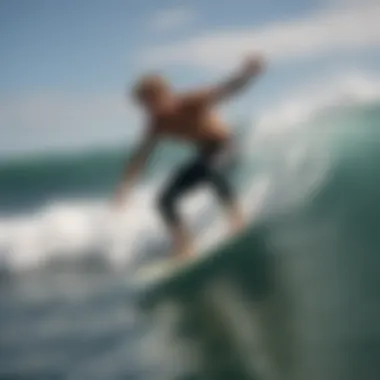
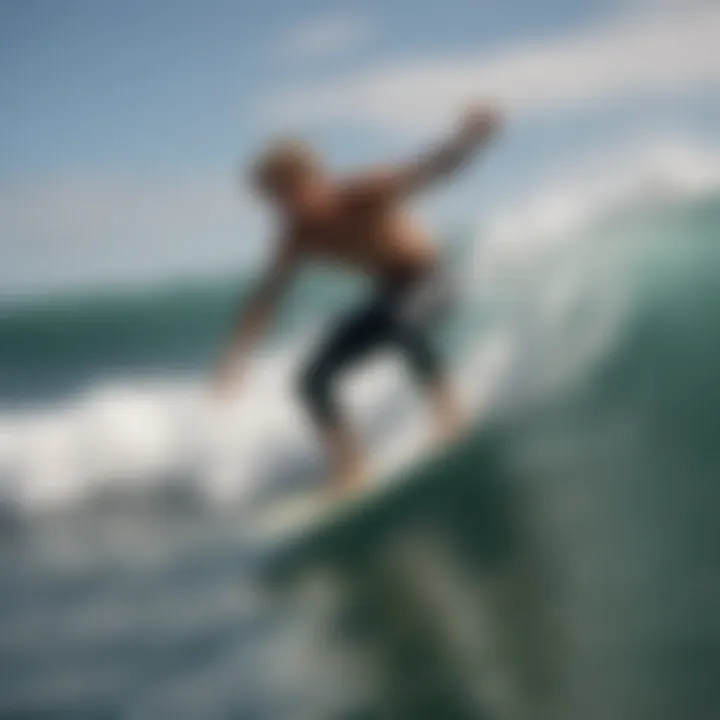
Intro
Every wave carries a story, a rhythm that speaks not just to the sea but to the surfer riding its crest. Surfboarding transcends mere physicality; it embodies a connection with nature, an embrace of adrenaline, and the notion of mastering one's domain. This guide intends to peel back the layers of surfing technique, revealing insights that resonate with both novices finding their footing and seasoned surfers perfecting their craft.
Understanding surf technique can be compared to peeling an onion—layer after tantalizing layer, until you reach the core. We’ll explore essential skills and advanced maneuvers that can elevate performance while ensuring a resonant bond with the ocean's pulse. Plus, there’s an essential aspect we cannot overlook: the community surrounding this art. Building relationships on the beach, sharing knowledge, and ensuring sustainability helps keep our playground alive for generations to come.
So, let’s dive into the nuances of surfboarding techniques and surfboard equipment that facilitate this exciting journey.
Surfboarding Techniques
Beginner Tips for Mastering the Basics
For those just getting their feet wet, the ocean can seem quite daunting. But fear not; like any skill worth mastering, starting with the basics sets the stage for greater adventures ahead. Here are some fundamental tips:
- Paddle with Purpose: A strong paddling technique is key. Engage your core and keep your strokes consistent.
- Stance Matters: Whether you're goofy or regular, find your natural stance. This will influence your maneuverability on the board.
- Timing is Everything: Catching a wave requires recognizing the swell before it breaks. Start paddling as you feel the push beneath you.
- Balance: Practice shifting your weight from your toes to your heels during small rides. This comes into play when turning or riding bigger waves.
Remember, practice is paramount. Spend time in the whitewater before paddling out to the lineup. Getting comfortable on smaller waves can build your confidence.
Advanced Techniques for Seasoned Surfers
Once you've mastered the basics, you’re likely itching to refine your skills. Advanced techniques boil down to precision and fluidity. Key strategies include:
- Carving: Practice shifting your weight smoothly through turns. This engaging technique helps maintain speed and control.
- Duck Diving: Essential for navigating through unbroken waves, this technique requires sinking your board while diving under the wave.
- Aerials and Tricks: Experiment with airs and tricks; a solid foundation will help you execute these maneuvers smoothly.
- Reading Waves: Developing a keen ability to read conditions will place you in the heart of the action, helping you anticipate swells and shifts in the surf.
"Surfing’s something you can’t really explain. You just have to feel it."
Mastering these techniques takes time but leads to a profound enjoyment of the ride. Maintain consistency in practice and embrace each session as an opportunity to learn.
Surfboard Equipment
Reviews of the Latest Surfboards on the Market
The surfboard you choose can dramatically shift your approach to surfing. Innovations continue to emerge, blending performance with sustainability. Here’s a selection worth checking out:
- Firewire Seaside: At the forefront of eco-friendly construction while delivering exceptional performance, it’s ideal for those who enjoy progressive ride styles.
- Lost Surfboards' Puddle Jumper: This model shines in small or weak waves, providing a relaxed yet responsive ride for experienced surfers seeking more.
- OluKai's Hopena Soft-Top: Perfect for beginners, this board offers stability and is made with environmentally friendly materials.
Essential Gear for Every Surfboarder
In addition to selecting the right board, ensuring you have the right gear is essential for every surfboarder:
- Wetsuits: Invest in a quality wetsuit that balances warmth and flexibility. Brands like O'Neill and Rip Curl push the envelope here.
- Leashes: A reliable leash can save many headaches in turbulent waters, so never skimp on this piece of gear, as they keep you connected to your board.
- Wax: Keep your grip in check with quality wax that suits your board and preferred conditions.
As you explore these elements, keep sustainability in mind—opt for brands that prioritize eco-friendly practices, keeping our oceans cleaner.
With this guide, we set the groundwork for understanding surf techniques. The dance between you and the ocean is ongoing; with each ride, you deepen your connection with its spirit and serenity.
Prelims to Surf Technique
Surfing, at its core, is a beautiful blend of art and science, a dance with the ocean that demands respect and skill. When we dive into surf technique, we uncover not just the mechanics of riding a wave, but the very essence of what makes surfing both exhilarating and challenging. Understanding surf technique is crucial for several reasons:
- Enhancing Performance: By mastering essential techniques, surfers can ride waves more proficiently, correcting mistakes before they lead to falls. Who wouldn’t want to look smooth and in control out there?
- Boosting Safety: Equipped with solid technique knowledge, surfers reduce risks associated with this sometimes unpredictable sport. Whether it's paddling safely out to the lineup or understanding how to fall without injury, technique is a key player.
- Heightening Connection with the Ocean: Surfing is not merely a sport; it’s a relationship with nature. Understanding how to read waves, the wind, and currents fosters a deeper appreciation for the aquatic world. It becomes more than riding a wave; it’s about being part of the ocean’s rhythm.
Every surfer, from a novice to a seasoned pro, can benefit from refining their technique. Whether one is gliding down a wave at Malibu or fighting against the whitewash at a local beach, the techniques discussed in this article offer valuable insights that can be applied universally in various conditions.
The Importance of Technique in Surfing
In the realm of surfing, technique forms the backbone of every maneuver and action taken on the water. A surfer's success greatly hinges on their ability to execute these techniques proficiently. For instance, imagine a scenario where a surfer attempts a bottom turn on a sizeable set. Without the correct technique, they risk losing control, potentially wiping out and compromising their safety.
Key benefits of mastering surf technique include:
- Increased Wave Count: Surfers with good paddling and positioning become adept in catching more waves, maximizing their time in the water.
- Fluidity in Movements: Proper technique leads to smooth transitions between maneuvers, which not only looks good but significantly improves performance.
- Confidence Boost: With improved skills, surfers naturally gain confidence, allowing them to push their limits and tackle bigger waves.
Ultimately, mastering technique not only aids an individual's experience in the water but enriches the collective community of surfers.
Different Levels of Surfers
Surfing respects no boundaries, welcoming everyone—from eager beginners to hardened veterans. Each level comes with its unique challenges and learning curves. Recognizing where one fits in this spectrum is essential for progression.
- Beginners: They often grapple with basic skills such as paddling and popping up. Key considerations for beginners include the importance of balance and reading the waves, as they lay the groundwork for more advanced maneuvers.
- Intermediate Surfers: They are beginning to refine their style, working on aspect like turns and speed. Here, the focus shifts from merely catching waves to performing with finesse.
- Advanced Surfers: At this level, surfers often focus on perfecting maneuvers and tackling challenging waves. They usually have a keen understanding of surf techniques and strategies for wave selection and usage.
Understanding these levels not only shapes one’s personal goals but also fosters a more supportive surfing community, where surfers learn from one another. Embracing one's place in this spectrum allows for continuous growth and enrichment in the sport.
"The ocean stirs the heart, inspires the imagination, and brings eternal joy to the soul." - Wyland, American artist known for his ocean-themed art.
Fundamental Skills
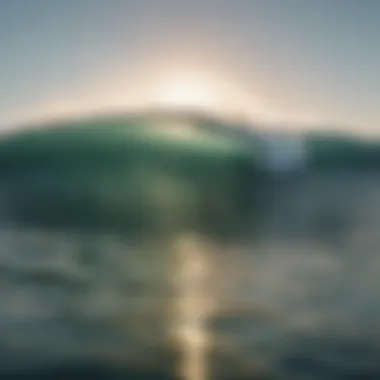
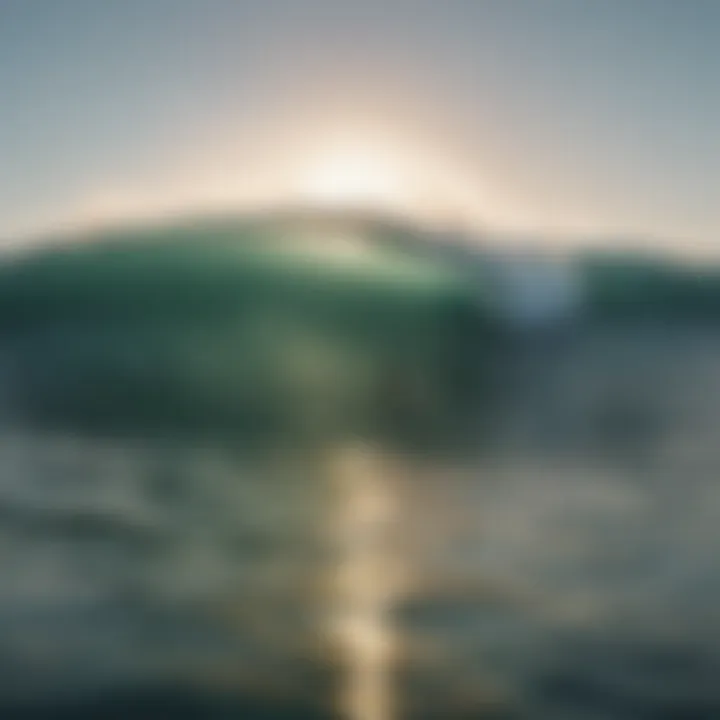
In the realm of surfing, mastering fundamental skills is akin to learning how to walk before running. These skills serve as the foundation upon which all further techniques are built. Without a solid grasp of the basics, one’s progression in surfing can become a long and arduous journey, often marked by frustration and ineffectiveness. Fundamental skills not only enhance performance but also contribute significantly to the enjoyment and safety of the sport.
Paddling Techniques
Paddling is the unsung hero of surfing. While it might seem elementary, effective paddling techniques can make a world of difference when it comes to catching waves and conserving energy. The ability to paddle efficiently determines how quickly a surfer can position themselves on the wave, influencing the overall experience in the water.
A crucial aspect of paddling is body positioning on the board. Surfers should lie flat, with their chest elevated to avoid drag, while allowing the legs to hang off the tail. This alignment helps the board cut through water with minimal resistance. It's often said that a good paddler can cover distance with half the effort of a poor paddler. This skill, therefore, reduces fatigue, allowing surfers more chances to catch those elusive waves.
When paddling out to deeper water, the "two-stroke" method comes in handy. As you reach forward with both arms, you should stroke down in the water with a strong yet controlled motion. Remember to angle your fingers slightly in the water for better grip. Consistency is key here; just like riding a bicycle, you'll get better with practice.
Pop-Ups: Getting to Your Feet
The pop-up is where the magic begins—transitioning from lying on the board to standing upright. This movement can feel awkward at first, but with refinement, it becomes as fluid as a dance move. A proper pop-up means the difference between catching a wave gracefully or tumbling into a watery mess.
Start by practicing on dry land. This helps internalize the mechanics without the added pressure of the ocean’s forces. Begin in a push-up position, then swiftly bring your feet underneath your body in one motion, standing up as your arms push off the board. It’s crucial to envision yourself driving up into the stance rather than merely jumping up. This visualization connects the necessary muscle movements, increasing your chances of success when it really counts.
"The pop-up isn't just about speed; it's about finesse. A confident pop-up can set the tone for your entire ride."
After you've perfected this skill on the sand, implement it in the water. Timing is paramount; you want to pop up just as you feel the wave beginning to carry you. This synchronicity helps maintain momentum and balance as you rise.
Stance and Balance
Once you’re up on the board, maintaining a solid stance becomes essential. Your stance plays a pivotal role not just in balance but also in how well you navigate through waves. Whether you adopt a regular or goofy stance, the positioning of your feet will affect your ability to carve and turn.
Most surfers find that a shoulder-width gap between their feet, with knees slightly bent, offers the best balance. It's often likened to finding a sweet spot—too wide, and you’ll lose control; too narrow, and you’ll be teetering like a one-legged flamingo.
Breath control and core engagement are equally important here. Keeping your torso upright and relaxed promotes better equilibrium. A good technique is to look ahead rather than down at your feet; this helps maintain stability, much like riding a bicycle. It’s about trusting your instincts while fine-tuning your body’s responses.
Engaging in balance exercises off the water can also enhance your performance on the board. Activities such as yoga or balance board training can amplify your surfing prowess. The goal is to create muscle memory that allows for a seamless and responsive ride.
Turning Techniques
Turning techniques are essential for any surfer looking to enhance their performance on the waves. They not only improve maneuverability but also allow surfers to maintain speed and control, adapting quickly to changing wave conditions. Mastering these techniques can pave the way for more advanced moves and contributes to a more enjoyable surfing experience.
Effective turning not only generates speed but also helps in carving a line through the water. It's the difference between simply riding the wave and showcasing precision and style. Let's explore the core turning techniques that every surfer should focus on.
Bottom Turns
The bottom turn is crucial as it's the first maneuver you perform once you catch a wave. It sets the stage for what follows and establishes a rhythm. Picture yourself as you paddle into the wave, pop up, and transition into that bottom turn. This maneuver involves leaning into the turn while keeping your weight centered. Using your back foot to drive your board against the wave face increases speed and allows for powerful transitions.
In the execution of a bottom turn:
- Shift your weight smoothly between both feet, allowing your board to grip the wave.
- Look ahead to where you want to go; your eyes lead your body.
- Use your shoulders to guide the board into the next maneuver.
The beauty of the bottom turn lies in its ability to connect other moves and maintain momentum. It's a building block for creativity on your board, leading into more complex actions.
Top Turns
Once you've mastered the bottom turn, you open the door to the top turn. This move is all about maintaining speed and direction while slicing through the wave's lip. The top turn is not just about how you move; it's also about timing and the wave's dynamics.
Key aspects to focus on include:
- Body Positioning: As you ascend the wave's face, crouch slightly to lower your center of gravity, which provides better balance.
- Weight Distribution: Similar to the bottom turn, keep your back foot engaged with the tail of the board to pivot effectively.
- Dynamism: Be prepared to engage your entire body, as the upper body controls the direction. A strong, fluid motion will yield a sharp turn.
This maneuver can be exhilarating, allowing surfers to showcase flair and agility while enjoying the power of the wave.
Cutbacks and Carves
Cutbacks and carves take turning techniques to a more advanced level, allowing surfers to regain the wave’s power while maintaining their line.
- Cutbacks involve returning towards the wave’s pocket after making a turn. This is often done when you feel your speed reducing. The key is to draw a tight arc back towards the wave’s energy, re-engaging with the water as you change direction. You want to carve into the water just enough to redirect without losing too much speed.
- Carving differs slightly as it focuses more on generating speed and creating dynamic lines across the wave face. Achieving a clean carve requires subtle body movements that effectively balance weight from heel to toe.
"A well-executed cutback can be the most visually pleasing maneuver, bringing together elegance and skill."
To master these techniques:
- Practice rotating your torso first, then shift your polarities between your feet. Start with small cutbacks and gradually increase your intensity.
- Know the wave: Reading the wave before executing turns gives you an advantage, allowing for calculated moves as you adapt to its changing face.
Overall, mastering turning techniques grants surfers the ability to perform at higher levels and explore their creativity with the ocean's many gifts.
Advanced Techniques
In the world of surfing, advancing from fundamental skills to more sophisticated techniques marks a surfer’s growth and understanding of the ocean's nuances. Advanced techniques not only elevate one’s performance but also enhance the joy and thrill associated with riding waves. Mastery of these techniques results in a surfer who can adapt to varying conditions and execute impressive maneuvers that draw both admiration and respect from peers.
Aerial Maneuvers
Aerial maneuvers, often considered the pinnacle of surfing brilliance, demonstrate a surfer's ability to defy gravity and showcase skill. These moves require exceptional timing, strength, and precise control. The beauty of aerials lies in their visual impact—nothing seems to captivate a crowd more than a cleanly executed air.


When attempting these moves, the key is in generating speed and projecting off the wave's lip. Here are some considerations for perfecting aerial maneuvers:
- Speed is crucial: Generate enough momentum before the take-off.
- Take-off angle: Approach the lip with the right inclination to catch air.
- Body positioning: Your stance matters; keep your knees bent and your center of gravity focused.
As you become increasingly comfortable with aerials like the straight air, you might want to challenge yourself with more complex tricks, such as the alley-oop or cork.
"Mastery of aerial maneuvers elevates your surfing game to new heights, literally and metaphorically."
Tube Riding Fundamentals
Riding inside the barrel of a wave, or tube riding, is an exhilarating experience that epitomizes what many surfers strive for. Mastering tube riding involves understanding water dynamics, as well as proper positioning on the board.
To successfully navigate the tunnel, here are the essentials:
- Positioning: Sit deeper on your board as the wave builds. The right spot can make all the difference.
- Timing: Drop in just right; too early or too late can be a one-way ticket to wipeout.
- Staying low: When in the tube, crouching creates less drag and helps maintain speed.
Practicing in different wave conditions will help you become adept at recognizing the right moment to enter the barrel, achieving that coveted ride that surfers dream of.
Power Turns and Snap Turns
Power turns and snap turns are essential techniques that help surfers navigate through the wave with agility and flair. They enable quick directional changes without losing momentum, crucial for maneuvering between sections of a wave effectively.
- Power Turns are characterized by a strong, sweeping motion that allows a surfer to maintain speed while changing direction significantly. They often involve engaging the back foot to dig the rail and push off hard through the turn.
- Snap Turns, on the other hand, are sharper and faster, often executed at the peak of the wave. The emphasis here is on quick transitions and explosive movement.
To master these turns, focus on:
- Body rhythm: Sync your arms and torso movements with your legs.
- Foot placement: Be aware of how your weight shifts during the maneuver.
- Visual tracking: Anticipate the wave's changes, as they can dictate how aggressively you can turn.
Understanding these advanced techniques is integral to developing a comprehensive surfing skill set, ensuring you can tackle various wave conditions with confidence and finesse.
Wave Dynamics
Understanding wave dynamics is crucial for mastering surfing techniques. Waves are not just random formations; they signify the ocean's moods and movements. By comprehending how waves behave, surfers can anticipate their actions, thus improving their performance and overall experience on the water. There are several facets to this, and knowing these can be the difference between catching the perfect wave and wiping out.
Understanding Wave Types
Waves come in various shapes and sizes, each presenting unique challenges and opportunities. Broadly, we can categorize waves into three types:
- Beach Breaks: These waves crash onto the beach and are often the most user-friendly, particularly for beginners. They break consistently and allow for safer entry and exit. The nature of beach breaks makes them popular among surf schools.
- Point Breaks: Point breaks occur when waves hit a point of land, usually creating longer rides. They can be trickier to navigate, but they often provide an exhilarating experience for more experienced surfers. The shape of these waves allows for spectacular maneuvers and flow.
- Reef Breaks: These occur over coral reefs and can become quite powerful. Although they may produce some of the most exhilarating rides, they come with higher risks due to the shallow water over the reef. An in-depth understanding of reef breaks can ensure safety while maximizing performance.
"A surfer's ability to read and adapt to different wave types is as vital as their physical skills on the board."
If you consider surfing as not just a sport but an art, knowing how to engage with varying waves is key to creating a masterpiece. When a surfer becomes adept at identifying these wave types, they can choose the right equipment and techniques to match the ocean’s rhythm and their individual style.
Reading the Ocean
Reading the ocean is an indispensable skill for surfers, akin to a radar system that coaches your every maneuver. Understanding swell patterns, tide changes, and local wind conditions will set you apart from the pack. Key points to consider while learning to read the ocean include:
- Swell Direction: Determines how waves will break on the reef or beach. For instance, a south swell may produce wonderful waves on a north-facing beach.
- Tides: The tide can dramatically affect wave size and shape. High tides might suit beach breaks; low tides can enhance the performance of reef breaks.
- Wind: Offshore winds tend to groom waves, holding them up and allowing for clean rides. Conversely, onshore winds can create choppy and unpredictable conditions, which can hamper performance.
By combining the understanding of wave types with reading the ocean, surfers develop a holistic perspective of surf dynamics. This knowledge not only enhances their enjoyment but also informs safer and more effective surfing decisions.
Surfers should always strive to stay informed about local conditions and natural patterns that can affect surfing experiences. Developing this attentiveness can transform a surfer's approach, making them more aware and connected with their environment.
Safety Considerations
In the thrilling, yet unpredictable world of surfing, safety considerations are paramount. Surfers, regardless of their skill level, must acknowledge the inherent risks involved in riding the waves. This section hones in on essential practices that not only safeguard the surfer but also elevate the overall experience of being in harmony with the ocean.
Equipment Safety Checks
Checking your gear is akin to a pilot doing pre-flight checks. You wouldn’t want to find out your parachute isn’t working when you're thousands of feet up. First and foremost, inspect your surfboard for dings and repairs—ensure it’s watertight. A board with damage can lead to serious accidents, especially when the waves are pumping.
Next, pay heed to your leash. It's a vital safety line, literally. Make sure it's securely attached to both your board and your ankle. A broken leash can mean you’re chasing after your board in potentially hazardous waters. Furthermore, don’t overlook your wetsuit. It should fit snugly and provide adequate flotation to assist you in case you fall into the ocean.
"An ounce of prevention is worth a pound of cure.”
A checklist might help during your routine checks:
- Board: No visible damages, fins secure, and waxed properly.
- Leash: No frays or knots, securely attached.
- Wetsuit: Good fit without major tears, warm enough for the conditions.
Surf Etiquette
Adhering to surf etiquette is just as crucial as wearing the right gear. Riding the waves isn't only about individual thrills; it involves respecting other surfers, the beach environment, and marine life. Ignoring these unwritten rules leads not only to mishaps but can escalate conflicts among surfers, which is never a good look. Always be respectful and patient, especially in crowded conditions.
First and foremost, the surfer closest to the peak of the wave has priority. It's a cardinal rule that ensures everyone enjoys the surf without collisions. Besides giving way when necessary, a simple wave or nod can go a long way to acknowledge others in the water. Also, keeping the line-up clean by taking trash off the beach is a gesture that embodies the surfer's connection to the ocean.
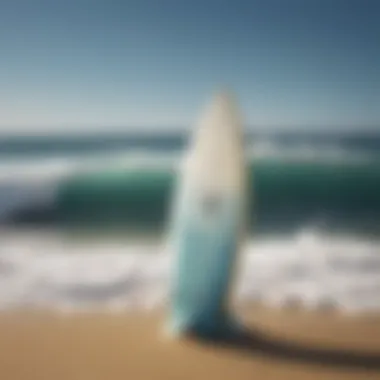
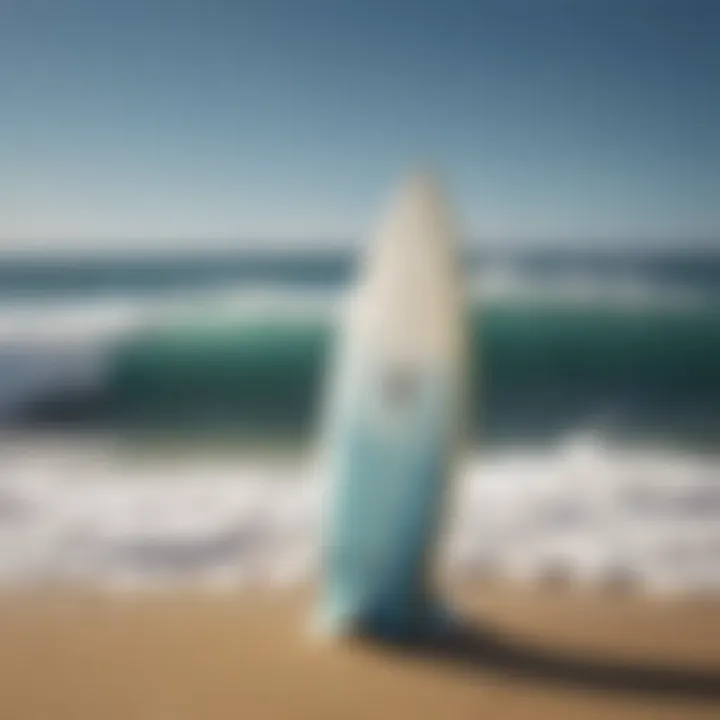
Some fundamental etiquette points:
- Priority: Respect wave right of way.
- Communication: Use friendly gestures to signal others.
- Cleanup: Always take your trash with you.
Recognizing Hazards
Being able to spot hazards while surfing is like wearing a pair of sunglasses on a bright day. It enhances your ability to navigate safely through challenging conditions. Hazards can range from natural elements like rip currents, rocks, and sharks to the human element, such as inexperienced surfers or misplaced longboards.
Begin by always checking the surf report. There’s a wealth of information available on sites like reddit.com or community forums, where you can learn not just about the waves but also about local hazards. Understanding the layout of the beach is equally essential—know where the rocks lurk and how the tide can change, sometimes rapidly.
Additionally, keeping an eye on the weather reports is crucial, for storms can brew unexpectedly, creating dangerous conditions. Here are some common hazards to look out for:
- Rip Currents: Look for differences in water color and wave patterns.
- Rocks and Reefs: Stay clear of areas marked with caution signs.
- Crowded Spots: Hustle to maintain distance from inexperienced surfers and large groups.
By focusing on safety considerations, surfers not only protect themselves but also cultivate a community that values respect, caution, and harmony with nature.
The Connection to Surf Culture
Surfing is more than just a sport; it's a deep and vibrant culture that intertwines with the lives of those who ride the waves. Understanding the connection to surf culture is critical for anyone looking to master their technique. This connection offers insights, drawn from decades of tradition and community wisdom, that resonate with every surfer, from the novice paddler to the seasoned pro.
Philosophy of Surfing
The philosophy behind surfing goes beyond the physical act of riding waves. At its core lies a profound respect for nature and a dedication to mindfulness. Surfers often speak about being in "the zone," a state of flow where time seems to vanish, and it’s just you, the board, and the rhythm of the ocean. This experience encourages a balance of mind and body, fostering not only athletic skills but also personal growth.
A core aspect of this philosophy is the virtue of patience. Just as wave patterns can shift and change, so do surf conditions. Mastering the mental game involves waiting for the right moment to ride, whether that’s tracking a swell or choosing the right board. Surfers learn to embrace the unpredictability of the ocean, transforming frustration into appreciation for the process. This mindset extends beyond surfing; it reflects an outlook on life, teaching resilience and adaptability.
Some principles from surf philosophy include:
- Respect for the Ocean: Recognizing nature’s power, surfers treat the sea with reverence and care.
- Connection with Others: Surfing fosters camaraderie among surfers. The shared passion creates bonds and friendships.
- Living in the Moment: Emphasizing the experience rather than just the outcome or competition encourages enjoyment and satisfaction.
The Role of the Community
Community is a foundational element of surf culture. From local surf clubs to global online forums, surfers find support and connection everywhere:
- Mentorship and Learning: More experienced surfers pass on their knowledge. This form of mentorship is crucial, helping newbies avoid pitfalls while also sharing techniques that may not be covered in traditional lessons.
- Environmental Activism: Surfers often rally around the cause of ocean conservation. The community takes action to protect beaches and marine life by advocating for sustainable practices and participating in beach cleanups.
- Social Interaction and Events: Surf competitions and festivals foster a strong sense of belonging. They allow surfers to showcase their skills, celebrate achievements, and share experiences with fellow enthusiasts.
- Online Communities: Platforms like Reddit and Facebook host vibrant discussions, tips, and videos that keep the global surf community connected, sprouting friendships across distances.
"The moment you slip into the ocean, the world melts away. This shared adventure isn’t just about catching waves; it’s about being part of something much larger—an ever-evolving culture that celebrates life's fluid nature."
Sustainability in Surfing
Surfing is often seen merely as a thrilling sport, offering an exhilarating connection to the waves. However, there's a growing recognition of the crucial role sustainability plays within this community. The ocean isn’t just our playground; it’s our responsibility. With surfers being some of the most frequent ocean-goers, our influence on the environment is significant. By adopting sustainable practices, we not only preserve the natural beauty of our surf spots but also ensure that future generations can enjoy the same experience and exercise we do today.
Sustainability in surfing encompasses various practices, mainly focused on preserving the delicate ecosystems where we ride the waves. Emphasizing eco-friendliness enhances our connection to nature and promotes awareness within the community. Here, we discuss specific elements, benefits, and critical considerations surrounding sustainability in surfing.
Eco-friendly Practices
Incorporating eco-friendly practices into our surfing lifestyle isn’t just a trend; it’s a necessary step for the environment. Surfers can actively help reduce their carbon footprint, making the ocean a cleaner, healthier place for all.
- Choosing Sustainable Gear: Opting for surfboards and wetsuits made from sustainable materials can greatly reduce environmental impact. Brands such as Sustainable Surf or Hippy Tree focus on creating eco-friendly surf equipment.
- Avoiding Single-use Plastics: Bringing reusable water bottles and snacks in eco-friendly containers, instead of single-use plastics, helps in keeping the beaches vibrant.
- Participating in Clean-up Events: Local surf clubs often organize beach clean-ups. Participating not only helps clear trash but also connects you with fellow surfers who care about the environment.
Adopting these practices can make a noticeable difference and contribute to the overall health of surf ecosystems.
Protecting Surf Spots
The places we love to surf are susceptible to human activity, pollution, and climate change. Protecting these surf spots requires collective action from the surfing community. Here are a few vital strategies:
- Advocacy for Policy Changes: Engaging in local governance and campaigns directed at environmental protection can lead to positive changes. This might include advocating for sustainable tourism, coastal management, or stricter pollution regulations.
- Responsible Surfing: Respecting surf limits and rules ensures that the local flora and fauna aren't disturbed. Staying in designated areas can help minimize our impact on ecosystems.
- Educating Others: Sharing knowledge about the importance of preserving surf spots with both seasoned and new surfers helps raise awareness. Consider organizing workshops focused on sustainability in surfing.
"The ocean is not just a resource; it’s our home. We need to treat it accordingly."
By taking these actions, we can ensure that our chosen surf spots continue to thrive. In summary, embracing sustainability in surfing is a collaborative effort that benefits both current surfers and future generations. Together, we can create waves of change that echo far beyond the beach.
Finale and Future Directions
In summarizing the journey of mastering surf technique, it's essential to recognize that this pursuit stretches beyond mere physical skill; it's a holistic blend of art, science, and culture. The concluding section serves not only as a summary but as a launching pad for surfers at every level to reflect on their personal growth, the technical skills they've acquired, and the ocean's ever-shifting nature. Embracing continuous learning transforms surfing from a pastime into a lifelong adventure. It underscores the notion that there's always something new to discover, whether it be refined techniques or fresh perspectives on wave dynamics.
Continuous Learning in Surfing
The surf world is rich with evolution; techniques mature, styles evolve, and technology shapes how we ride waves. Committing to ongoing education is crucial. Here are some key elements to consider in this journey:
- Stay Updated: Surfing technology, gear, and methodology are constantly changing. Following reputable blogs, attending workshops, or simply chatting with seasoned surfers can unveil new insights. For instance, knowing when a new surfboard shape or fin design might better suit your style can maximize performance.
- Reflect on Sessions: After each surf, take a moment to reflect. What went well? What could be improved? Keeping a surf journal can be helpful. Write about conditions, feelings, and challenges you've faced. Over time, patterns may emerge, providing valuable feedback for improvement.
- Take Lessons: Even experienced surfers can benefit from professional coaching. A different set of eyes can catch mistakes or habits that may hinder progress. Plus, many instructors offer tailored techniques based on wave conditions, bringing a fresh take to your usual maneuvers.
Continuous learning is not about attaining perfection but rather about enhancing enjoyment, understanding, and connection to the ocean.
Join the Surf Community
The surf community is an integral component of the sport. When surfers come together, they share more than just waves; they exchange passion, stories, and wisdom that enriches the surfing experience profoundly. The benefits of engaging with this community include:
- Networking with Like-Minded Individuals: Meeting fellow surfers can open doors to new friendships and collaborations. Don’t underestimate the thrill that comes from paddling out with someone who shares your values and excitement for the ocean.
- Participating in Local Events: From competitions to beach clean-ups, getting involved shows a commitment to both surfing and the local environment. Contributing to local events can boost your reputation and introduce you to experienced surfers and mentors.
- Learning from Community Wisdom: Each surfer has unique tales and techniques. Listening to their experiences can provide insights into overcoming challenges you've faced or will face in the water. The stories shared—of wipeouts, breakthroughs, or epic rides—often carry lessons that resonate deeply and last a lifetime.
The connection to the community enhances the surfing experience, embedding a deeper appreciation for the ocean and the sport itself.
"The ultimate level of mastery is not being the best, but being part of something greater than oneself.”
In summary, as surf enthusiasts reflect on the insights gathered throughout this comprehensive exploration of surf technique, they are encouraged to embrace the perpetual journey of learning and community engagement. The waves keep rolling in, and so should our desire to learn, grow, and connect.















